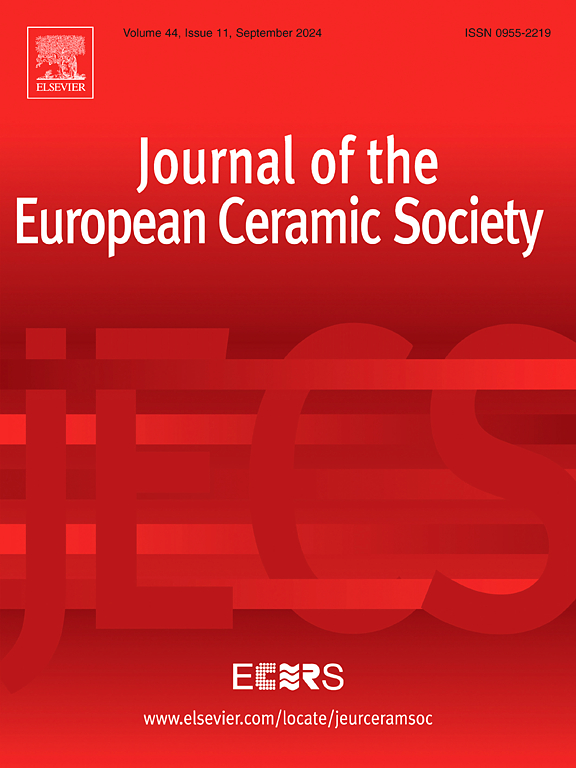层间极化修饰srla2al2o7基微波介电陶瓷的高Qf和近零τf
IF 5.8
2区 材料科学
Q1 MATERIALS SCIENCE, CERAMICS
Journal of The European Ceramic Society
Pub Date : 2025-04-29
DOI:10.1016/j.jeurceramsoc.2025.117493
引用次数: 0
摘要
通过在a位用Sr2+取代La3+,在b位用Ti4+取代Al3+,提高了SrLa₂Al₂O₇陶瓷的微波介电性能,特别是质量因子(Qf)和谐振频率温度系数(τf)。采用固相法合成了纯相Sr/Ti共取代Sr1+2xLa2−2xAl2−2xTi2xO7陶瓷。值得注意的是,在一个最佳的替代水平的x = 0.55,结果Sr2.1La0.9Al0.9Ti1.1O7陶瓷表现出优越的微波介电性能:εr = 25.94 ±0.32 ,Qf = 117300 ±5700 GHz (f0 = 6.40 GHz),τf = 3.28 ± 0.17 ppm /°C。Qf值的增大与层间极化电荷绝对值小导致层间极化效应减弱密切相关。τf值受τε和b位键价的共同支配。本文章由计算机程序翻译,如有差异,请以英文原文为准。
High Qf and near-zero τf of SrLa2Al2O7-based microwave dielectric ceramics modified by interlayer polarization
The microwave dielectric properties of SrLa₂Al₂O₇ ceramic, specifically the quality factor (Qf) and temperature coefficient of resonant frequency (τf), were enhanced through substituting La3+ with Sr2+ at the A-site and Al3+ with Ti4+ at the B-site. Pure-phase Sr/Ti co-substituted Sr1+2xLa2−2xAl2−2xTi2xO7 ceramics were synthesized via solid-phase reaction route. Remarkably, at an optimal substitution level of x = 0.55, the resulting Sr2.1La0.9Al0.9Ti1.1O7 ceramic exhibited superior microwave dielectric properties: εr = 25.94 ± 0.32, Qf = 117,300 ± 5700 GHz (f0 = 6.40 GHz), τf = 3.28 ± 0.17 ppm/°C. The increase of Qf value was highly associated with the low interlayer polarization effect caused by the small absolute value of interlayer polarization charges. The τf value was jointly dominated by both τε and the bond valence of B-site bonds.
求助全文
通过发布文献求助,成功后即可免费获取论文全文。
去求助
来源期刊

Journal of The European Ceramic Society
工程技术-材料科学:硅酸盐
CiteScore
10.70
自引率
12.30%
发文量
863
审稿时长
35 days
期刊介绍:
The Journal of the European Ceramic Society publishes the results of original research and reviews relating to ceramic materials. Papers of either an experimental or theoretical character will be welcomed on a fully international basis. The emphasis is on novel generic science concerning the relationships between processing, microstructure and properties of polycrystalline ceramics consolidated at high temperature. Papers may relate to any of the conventional categories of ceramic: structural, functional, traditional or composite. The central objective is to sustain a high standard of research quality by means of appropriate reviewing procedures.
 求助内容:
求助内容: 应助结果提醒方式:
应助结果提醒方式:


